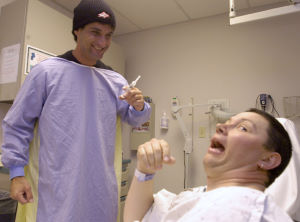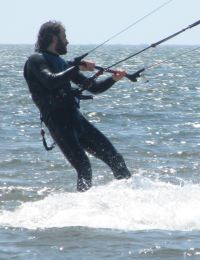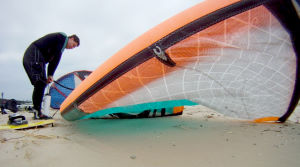Fat Guys Can Kiteboard Too!

Fat Guys Can Kiteboard Too!
The Impact of Weight when Kiteboarding
Hi, I'm Jake and I like to eat and kiteboard. Oh, and yeah- I weigh 260 lbs.
To give you a little background, in 2006 I blew out my foot while kiteboarding. Actually, I was trying to do a hooked in back-roll kite-loop that went horribly wrong... Well, 4 months on crutches and 3 months of physical therapy later, I was able to walk- well sort of.
It was another year and a half until I tried kiteboarding again in 2008. In that year and a half I gained 40 lbs working a desk job and eating and drinking a lot of beer! Yum. Well...
 Over the past 5 years, I have kiteboarded when time permits, but obviously not enough since I have gained another 10 lbs in the past couple years. Yup, maxing out at 268 and boy, is that 50 lbs noticeable on the water when riding.
Over the past 5 years, I have kiteboarded when time permits, but obviously not enough since I have gained another 10 lbs in the past couple years. Yup, maxing out at 268 and boy, is that 50 lbs noticeable on the water when riding.
In 2008 I was convinced no one needed a kite larger than a 14m bow kite, a Cabrinha Contra to be exact, because why on earth would anyone want to ride in wind under 16-17 MPH. Well, that was me being stupid to say the least. I really couldn't kiteboard and stay upwind even with my Aggression Custom Barndoor, a super wide and flat light wind specific board at the 16 MPH mark like I was thinking I could; I just passed it off as not being as efficient as I was back in 2006. HAHA yeah, right. I simply didn't have the right sized gear for my "big boned" body... Needless to say I was getting frustrated.
Well, in 2012 I had a chance to talk to my favorite brand rep Ryan from Best Kiteboarding about large kites--as in, over 17 meters--and he convinced me to try their 17m TS. I really had pretty low expectations. Like I said, I still thought kites larger than 14m were STUPID...
 After flying the TS from Best Kiteboarding I realized that, even though I was 268 lbs, I could still have a lot of fun in light wind. You see, I was actually able to ride and stay upwind in 14 MPH. Ride and jump going downwind at about 12 MPH. I couldn't believe it- my arrogance and bull headedness kept me from riding in the low teens for 4 years. It also made it painfully obvious just how much weight comes into play when kiteboarding in the wind range of 12-19 MPH. (Yeah, I know- "knots" are used in sailing... Well, I'm not a sailor so deal with it...)
After flying the TS from Best Kiteboarding I realized that, even though I was 268 lbs, I could still have a lot of fun in light wind. You see, I was actually able to ride and stay upwind in 14 MPH. Ride and jump going downwind at about 12 MPH. I couldn't believe it- my arrogance and bull headedness kept me from riding in the low teens for 4 years. It also made it painfully obvious just how much weight comes into play when kiteboarding in the wind range of 12-19 MPH. (Yeah, I know- "knots" are used in sailing... Well, I'm not a sailor so deal with it...)
Here is the deal with weight and riding. Let's use my weight and Tucker's weight of 170 lbs as a comparison, along with the Best TS as the baseline kite. A 270 lb rider can get up and ride, although you will be doing the walk of shame at 12-13mph on flat water with the a kite similar to the TS. Tucker at 170lbs on the same kite can be riding boots on a wakestyle board at the same speed.
At 15-16 MPH, when a 170 lb rider might choose to ride a 12m kite, a 270 lb rider will be having the time of their life on a 17-18m kite, and with experience that 270 lb rider will be able to ride that same kite up to about 22-23 MPH while on the water. At 25 MPH the TS was manageable on the water fully sheeted in, but a bit of a handful while standing on the beach. Tucker mentioned that he experienced the same feeling at 17-18 MPH when he was on the TS. A rockered out wakestyle board will give you a few more MPH on the top end of any size kite.
 Here is a quick rough sizing chart for what a couple of the guys in the shop run as a quiver.
Here is a quick rough sizing chart for what a couple of the guys in the shop run as a quiver.
Rider - Kite size/Wind Speed
Tucker @ 170 LBS - Single board quiver
17-18m / 10-17 MPH
12m / 15-25 MPH
9m / 25-35 MPH
7m / 35+ MPH
Steve @ 200 LBS
17-18m / 10-17 MPH
14m / 15-25 MPH
10m / 23-35 MPH
7 / 35+ MPH (He usually doesn't ride in this in Michigan)
 Me at 270 LBS (Likely pushing 280 with all the gear on) - 2 board quiver
Me at 270 LBS (Likely pushing 280 with all the gear on) - 2 board quiver
17-18m / 12-23MPH
12m / 18-28 MPH
10m / 22-35 MPH
8-7m / 35+ MPH (I usually don't ride in this in Michigan either)
As you can see, the kite sizes get closer and closer as the wind speed increases, and the difference is gone once you hit the 35-40 MPH range. The only difference in gear is the size of board we are all riding. I am always on a bigger, usually flatter, board compared to all the guys at the shop until we get over the 35-40 MPH range. At this point, and I have to admit I have only ridden in these conditions a couple times on flat water in Hatteras, I can be on the exact same board and kite as a 160-170 lbs rider.
The weight of the rider and kite size is exaggerated only when the wind is light, but it is still doable. If you are a heavier person interested in learning how to kite board, keep this in mind: if your 160 lb instructor tells you that a 12m is the perfect size kite to learn on, punch him in the throat. A 12m with a flat, wide board is only doable at the 18-20MPH mark for me at 250-300 LBS; you simply need more cloth in the sky. Plain and simple.
 Board size is just as important as getting the right size kite. I have to have a light wind specific board in my car at all times. Even with a kite like the 17m Best TS or the 18m Cabrinha Crossbow, big riders need a board that will glide through the lulls. In the wind at 15MPH with 3MPH lulls, rocker in your board will crush your rate of speed and you will be slogging around. Be sure you are able to stay on plane, and learn when to edge your flat board and when to ride it flat on the water with the fins to control your direction.
Board size is just as important as getting the right size kite. I have to have a light wind specific board in my car at all times. Even with a kite like the 17m Best TS or the 18m Cabrinha Crossbow, big riders need a board that will glide through the lulls. In the wind at 15MPH with 3MPH lulls, rocker in your board will crush your rate of speed and you will be slogging around. Be sure you are able to stay on plane, and learn when to edge your flat board and when to ride it flat on the water with the fins to control your direction.
Oh, and one final thing for you big guys (230+ lbs) looking to take kiteboarding lessons, when it is time to learn water starts and your instructor hands you a 12m in 15mph, ask for them to pump up a little larger kite. Honestly, a 14-16m kite will make the experience easier and more enjoyable for you. If they say "no, that is unsafe," grab a kite bag, fill it with sand, and have your instructor try to do a water start with it strapped to their back. It will become painfully obvious the impact that the extra 80-100 lbs that you have on them plays when you are trying to kiteboard.
And if you are an instructor and you are reading this, I challenge you to try it, ok maybe not on the water with sand-- I don't want to feel responsible for your drowning--but how about trying pull ups with a kite bag full of sand or water bottles. Trust me, it will be an eye opener and your gear recommendations will only get better.
